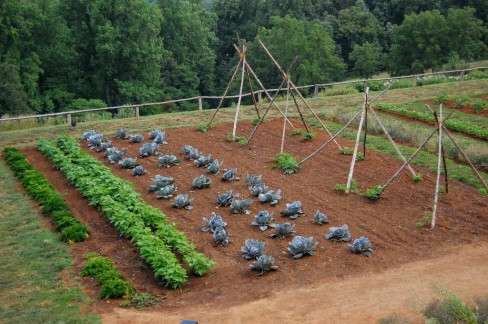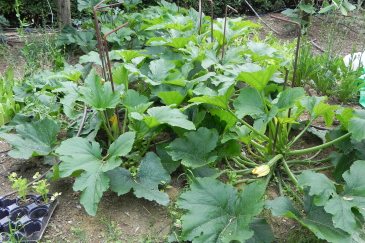 Our friend and Master Gardener Lucy Valitchka has been successfully growing vegetables longer than many of our members have been gardening. Each year, we ask Lucy to teach our new class the section on Vegetables, and she also graciously supplies an article for our Summer Newsletter. Because that information is too valuable to keep to ourselves, we’re reprinting it here.
Our friend and Master Gardener Lucy Valitchka has been successfully growing vegetables longer than many of our members have been gardening. Each year, we ask Lucy to teach our new class the section on Vegetables, and she also graciously supplies an article for our Summer Newsletter. Because that information is too valuable to keep to ourselves, we’re reprinting it here.
“During the growing season gardeners know that timing of jobs in the garden impact the final produce harvested. That is the reason behind these calendar jobs listed in each newsletter. Maybe some people remember it easily, but I need a reminder just to make sure the job gets done in time. For new readers of this column, I try to include a calendar of garden tips for each month. This is taken from Madison Area Master Gardener’s Association garden journal no longer published.
June Week 1
- Control anthracnose and other disease problems by staking plants, maintaining optimal plant spacing and using mulches.
- Tie tall crops, such as tomatoes, or cage them, to support as they grow.
- Before setting out tomato cages, disinfect them with a 10% bleach solution or spray cages with rubbing alcohol. (I do that before I store them for the winter.)
- Start seedlings of brussels sprouts to transplant in mid July.
- Plant peppers, eggplants, sweet potatoes and late potatoes.
June Week 2
- Plant successive crops of beans, beets, carrots, kohlrabi, corn, turnips, broccoli, cabbage and cauliflower.
- As soil warms apply a mulch after deep watering or heavy rain.
- Control leaf blight on tomatoes by disposing of diseased foliage or plants immediately or planting disease-resistant varieties.
- Control cabbage worm and cabbage looper on cabbage, cauliflower and broccoli.
June Week 4
- Thin vegetables for proper spacing.
- Plant rutabagas, late cabbage, cauliflower and broccoli.
- Mulch tomatoes and water them, if necessary.
- Stop harvesting asparagus. Weed asparagus bed carefully after harvesting to avoid damage to roots.
July
- Renew mulch if it starts to decompose.
- Make daily inspections for pests, and treat, if necessary.
- Control garden weeds to prevent them going to seed.
- Harvest onions, garlic, and early potatoes when tops begin to shrivel.

July Week 1
- Plant lettuce and spinach for fall crop. Pre-germinate seeds on moist towel, or plant deeper than spring planting. Mulch thinly.
- Watch for squash vine borer. Remove floating row covers from cucumbers and melons as soon as they begin to bloom so that they can be pollinated. Use a reflective mulch such as aluminum foil to repel squash vine borers.
- Plant collards, kale, bunching onions and cucumbers for fall harvest.
July Week 2
- Plant beets, Chinese cabbage, rutabagas and turnips for fall harvest.
- Fertilize asparagus beds. Mulch with straw.
- Keep tomatoes mulched and watered to prevent blossom end rot.
July Week 3
- Transplant broccoli, Brussels sprouts, and cauliflower seedlings for fall crop.
- Plant chard for fall crop.
July Week 4
- Plant fall crop of peas. Keep plants picked to maintain productivity.
August
- Sow cover crops in garden areas not in use.
- Pick herbs just before blossoms open for best flavor.
- Inspect corn regularly. Corn pests become abundant in mid-August.
August Week 1
- Keep eggplant and peppers picked so younger fruit develops.
- Plant late crops of radishes, lettuce, spinach and beets.
 Some parting wisdom taken from an article about Gardening in Grandfather’s Time by Jerry Minnich in the 2012 Wisconsin Garden Journal: Connections Through Time “Sometimes it’s true: The more things change, the more they stay the same. And despite all the new wrinkles in gardening, our greatgreatgrandchildren will probably be planting potatoes just as we do, hill by hill, row by row, eyes always up. Through the generations, gardeners will always be connected.” Jerry Minnich is the author of several gardening books, including The Wisconsin Garden Guide, published in 2010. “
Some parting wisdom taken from an article about Gardening in Grandfather’s Time by Jerry Minnich in the 2012 Wisconsin Garden Journal: Connections Through Time “Sometimes it’s true: The more things change, the more they stay the same. And despite all the new wrinkles in gardening, our greatgreatgrandchildren will probably be planting potatoes just as we do, hill by hill, row by row, eyes always up. Through the generations, gardeners will always be connected.” Jerry Minnich is the author of several gardening books, including The Wisconsin Garden Guide, published in 2010. “
Hi Vicki,
That was a pleasant surprise to see my column in Garden Snips. Thank you for considering it. Hopefully it will be helpful to any who read it.
Lucy
LikeLike
Lucy – your expertise and information are always valuable and I’m pleased to be able to share it.
LikeLike